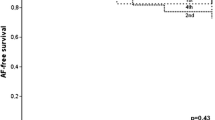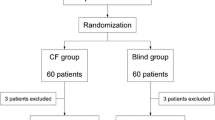Abstract
Purpose
Use of online contact force (CF) measurement during circumferential pulmonary vein (PV) isolation (CPVI) for atrial fibrillation (AF) has demonstrated improvements in procedural parameters and mid-term clinical outcome. However, it is unknown if experience gained with CF measuring catheters improves the efficacy of subsequent CPVI procedures performed without CF measurement.
Methods
This prospective trial compared procedural results of CPVI performed without a CF measuring catheter to a control group performed with a CF measuring catheter, by an operator with prior experience with CF technology..
Results
Thirty-six eligible paroxysmal (n = 27) or persistent (n = 9) AF patients were consecutively enrolled. Twelve patients underwent CPVI with the non-CF catheter (CF− group) in a recall period and 24 with the CF catheter (CF+ group). After the first circumferential lesion set, the number of PV pairs requiring additional touch-up lesions to achieve electrical isolation was significantly less in the CF+ group (2 of 48 (4.2 %) vs. 7 of 24 (29.2 %) in the CF+ and CF− groups, respectively, p = 0.005). The procedure time was significantly lower in the CF+ group (117.9 ± 23.3 vs. 134.1 ± 25.3 min, p = 0.033). Radiofrequency (RF) and fluoroscopy time did not differ between groups (31.5 ± 7.1 vs. 31.8 ± 7.0 min and 11.8 ± 5.6 vs. 11.0 ± 5.8 min in the CF+ and the CF− group, respectively)
Conclusions
With the use of online CF measurement, PV isolation is more frequently complete following the first circumferential lesion set. A previous learning period with direct CF feedback is not a substitute for real-time direct CF measurement to maintain this advantage.
Similar content being viewed by others
References
Calkins, H., Kuck, K. H., Cappato, R., Brugada, J., Camm, A. J., Chen, S. A., et al. (2012). 2012 HRS/EHRA/ECAS Expert Consensus Statement on Catheter and Surgical Ablation of Atrial Fibrillation: recommendations for patient selection, procedural techniques, patient management and follow-up, definitions, endpoints, and research trial design. Heart Rhythm, 9, 632–696.
Haines, D. E. (1991). Determinants of lesion size during radiofrequency catheter ablation: the role of electrode-tissue contact pressure and duration of energy delivery. Journal of Cardiovascular Electrophysiology, 2, 509–515.
Avitall, B., Mughal, K., Hare, J., Helms, R., & Krum, D. (1997). The effects of electrode-tissue contact on radiofrequency lesion generation. Pacing and Clinical Electrophysiology, 20, 2899–2910.
Strickberger, S. A., Vorperian, V. R., Man, K. C., Williamson, B. D., Kalbfleisch, S. J., Hasse, C., et al. (1994). Relation between impedance and endocardial contact during radiofrequency catheter ablation. American Heart Journal, 128, 226–229.
Zheng, X., Walcott, G. P., Hall, J. A., Rollins, D. L., Smith, W. M., Kay, G. N., et al. (2000). Electrode impedance: an indicator of electrode-tissue contact and lesion dimensions during linear ablation. Journal of Interventional Cardiac Electrophysiology, 4, 645–654.
Nath, S., DiMarco, J. P., Gallop, R. G., McRury, I. D., & Haines, D. E. (1996). Effects of dispersive electrode position and surface area on electrical parameters and temperature during radiofrequency catheter ablation. American Journal of Cardiology, 77, 765–767.
Eick, O. J., Wittkampf, F. H., Bronneberg, T., & Schumacher, B. (1998). The LETR-Principle: a novel method to assess electrode-tissue contact in radiofrequency ablation. Journal of Cardiovascular Electrophysiology, 9, 1180–1185.
Wittkampf, F. H., & Nakagawa, H. (2006). RF catheter ablation: lessons on lesions. Pacing and Clinical Electrophysiology, 29, 1285–1297.
Wakili, R., Clauss, S., Schmidt, V., Ulbrich, M., Hahnefeld, A., Schüssler, F., Siebermair, J., Kääb, S., & Estner, H. L. (2014). Impact of real-time contact force and impedance measurement in pulmonary vein isolation procedures for the treatment of atrial fibrillation. Clinical Research in Cardiology, 103, 97–106.
Di Biase, L., Paoletti, P. A., Mohanty, P., Goldenberg, A. S., Grifoni, G., Santangeli, P., et al. (2014). Visual, tactile, and contact force feedback: which one is more important for catheter ablation? Results from an in vitro experimental study. Heart Rhythm, 11, 506–513.
Kuck, K. H., Reddy, V. Y., Schmidt, B., Natale, A., Neuzil, P., Saoudi, N., et al. (2012). A novel radiofrequency ablation catheter using contact force sensing: Toccata study. Heart Rhythm, 9, 18–23.
Park, C. I., Lehrmann, H., Keyl, C., Weber, R., Schiebeling, J., Allgeier, J., et al. (2014). Mechanisms of pulmonary vein reconnection after radiofrequency ablation of atrial fibrillation: the deterministic role of contact force and interlesion distance. Journal of Cardiovascular Electrophysiology, 25, 701–708.
Martinek, M., Lemes, C., Sigmund, E., Derndorfer, M., Aichinger, J., Winter, S., et al. (2012). Clinical impact of an open-irrigated radiofrequency catheter with direct force measurement on atrial fibrillation ablation. Pacing and Clinical Electrophysiology, 35, 1312–1318.
Sciarra, L., Golia, P., Natalizia, A., De Ruvo, E., Dottori, S., Scarà, A., et al. (2014). Which is the best catheter to perform atrial fibrillation ablation? A comparison between standard ThermoCool, SmartTouch, and Surround Flow catheters. Journal of Interventional Cardiac Electrophysiology, 39, 193–200.
Marijon E., Fazaa S., Narayanan K., Guy-Moyat B., Bouzeman A., Providencia R., et al. (2013). Real-time contact force sensing for pulmonary vein isolation in the setting of paroxysmal atrial fibrillation: procedural and 1-year results. Journal of Cardiovascular Electrophysiology. 25(2):130–137.
Wutzler, A., Huemer, M., Parwani, A. S., Blaschke, F., Haverkamp, W., & Boldt, L. H. (2014). Contact force mapping during catheter ablation for atrial fibrillation: procedural data and one-year follow-up. Archives of Medical Science, 10, 266–272.
Kimura, M., Sasaki, S., Owada, S., Horiuchi, D., Sasaki, K., Itoh, T., et al. (2014). Comparison of lesion formation between contact force-guided and non-guided circumferential pulmonary vein isolation: a prospective, randomized study. Heart Rhythm, 11, 984–991.
Haldar, S., Jarman, J. W., Panikker, S., Jones, D. G., Salukhe, T., Gupta, D., et al. (2013). Contact force sensing technology identifies sites of inadequate contact and reduces acute pulmonary vein reconnection; a prospective case control study. International Journal of Cardiology, 168, 1160–1166.
Reddy, V. Y., Shah, D., Kautzner, J., Schmidt, B., Saoudi, N., Herrera, C., et al. (2012). The relationship between contact force and clinical outcome during radiofrequency catheter ablation of atrial fibrillation in the TOCCATA study. Heart Rhythm, 9, 1789–1795.
Neuzil, P., Reddy, V. Y., Kautzner, J., Petru, J., Wichterle, D., Shah, D., et al. (2013). Electrical reconnection after pulmonary vein isolation is contingent on contact force during initial treatment: results from the EFFICAS I study. Circulation. Arrhythmia and Electrophysiology, 6, 327–333.
Ren, J. F., Callans, D. J., Schwartzman, D., Michele, J. J., & Marchlinski, F. E. (2001). Changes in local wall thickness correlate with pathologic lesion size following radiofrequency catheter ablation: an intracardiac echocardiographic imaging study. Echocardiography, 18, 503–507.
Andrade, J. G., Monir, G., Pollak, S. J., Khairy, P., Dubuc, M., Roy, D., Talajic, M., Deyell, M., Rivard, L., Thibault, B., Guerra, P. G., Nattel, S., & Macle, L. (2014). Pulmonary vein isolation using “contact force” ablation: the effect on dormant conduction and long-term freedom from recurrent atrial fibrillation—a prospective study. Heart Rhythm, 11, 1919–1924.
Conflict of interest
None declared
Author information
Authors and Affiliations
Corresponding author
Rights and permissions
About this article
Cite this article
Wolf, M., Saenen, J.B., Bories, W. et al. Superior efficacy of pulmonary vein isolation with online contact force measurement persists after the learning period: a prospective case control study. J Interv Card Electrophysiol 43, 287–296 (2015). https://doi.org/10.1007/s10840-015-0006-4
Received:
Accepted:
Published:
Issue Date:
DOI: https://doi.org/10.1007/s10840-015-0006-4




